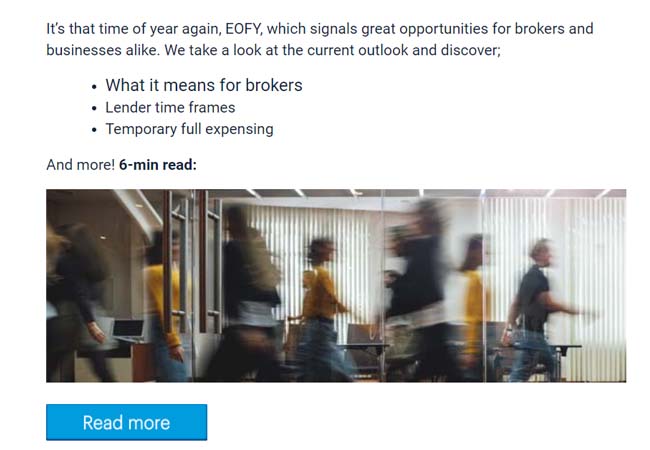Did you know? Content is crucial for any business looking to attract people and drive sales.
The phrase “content is king” has been commonplace in marketing brainstorms and discussions across the globe since Bill Gates coined the term back in 1996. All these years later, content looks a lot different and with a huge range of platforms to share your brand story, but we can confidently say that content is most certainly still king.
So why is content so important? What is the fuss about?
Nodifi will take you through the art of content, tips and tricks for success and help you discover how amazing content can help elevate your business to new heights and introduce you to new audiences.
What is digital content?
Digital content is a broad term that refers to anything published online by a business to engage with their target audience whether they be a website visitor, a social media user or even a customer.
Content marketing is used by big and small brands around the world to increase brand awareness, drive leads and position the brand in a certain way for the audience, e.g., a thought provoker, source of quality information or trendsetter.
“Content” is a wide paintbrush and can include:
- Articles / blogs / reports
- Videos
- Surveys
- Infographics
- How-to guides
- Newsletters
- Stats / facts
Content is usually published on platforms such as:
- YouTube
- Social media (eg. Facebook (Meta), LinkedIn, TikTok)
- A website
- 3rd-party websites
Of course, the content will have the business’s name and logo and, depending on the type of content, contact details, links to their website and CTA (Call to Action) buttons, like a button to begin a quote.

The above is an example of how strategically published content can help achieve the content’s goal, such as converting customers. The ‘Read more’ button invites viewers to the Nodifi website in this case.
Why is digital content important?
Creating consistent content that speaks to your target audience about your expertise gets people involved and builds trust in what you offer.
Great content creates an even playing field to go up against big competitors because businesses of all sizes can create compelling, fun and interesting content that reaches audiences on a personal level by focusing on their interests, wants and needs.
It is also a cost effective marketing tactic with the ability to use one piece of content across multiple platforms in a range of different ways to reach a wider audience.
An example of content marketing in action
A mortgage broker crafts a detailed article on how to prepare for a first home loan and publishes it on their website. If that article is buried away on a ‘resources’ tab within the website, it won’t get much publicity until Google gets wind of it, gains data and begins listing it on results pages – this can take many months.
To get the article (content) out there, the broker cherrypicks snippets from the article and creates relatable images for social media with links in the copy (text) back to the article on their website. People see this on social media and are exposed to the business, ideally clicking the links in the posts to find out more and land on the website.
Content marketing builds scale and longevity
Depending on the topic, strong content pieces can be used across multiple platforms and reworked in the future to be shared again with some minor tweaks.
In the example above, the broker could use the article again in the future by creating new social media posts, again linking to the article which has been updated with new up-to-date information.
If the content has performed well as an article they might decide it is worth turning into a video to be shared across YouTube and TikTok to reach new audiences.
Other than sharing on social media, articles like this can also be used in:
- Welcome packs (for new clients)
- Newsletters
- Paid social media activity
- Paid content on 3rd party websites
SEO (Search Engine Optimisation)
Another key reason why so many businesses are now investing time and resources in creating content is the opportunity presented by SEO.
No surprises here, Google is the search engine of choice, with over 92% of the search market share globally. Meaning that ranking on Google for a variety of keywords is key to success for any business looking for online exposure with minimal costs.
Rank = where a website page sits in search results. Being high up on page one is the goal.
For example, when publishing an article on a website, the creator can select keywords for search engines to pick up and rank for. If the article becomes a popular, high-ranking page for popular keywords it can drive free traffic to the website with audiences actively looking for the information and guidance.
In other words, creating great content brings free website traffic.
Google SEO quick stats
- 300,000 Google searches daily in Australia
- Google’s search algorithm uses more than 200 factors to rank websites
- Well-performing SEO reduces the cost of customer acquisition by 87.41% on average
- Page one of Google’s search results receive around 90% of all clicks
SEO tips
- Google knows what to look out for when ranking website pages and prefers unique, easy to read content
- Avoid keyword stuffing (over using keywords to rank high)
- Google can detect plagiarism so do not copy-paste from other websites
- Most experts put ideal length at 2,100 – 2,500 words
- Avoid long, boring blocks of text
- Add images and subheadings
Unsure on how to get started on your next blog article? This might help.
Step by step guide to creating strong content
When you start building out your content it is important to remember it is the bridge between you and your target audience. Bill Gates’ belief that content is king came from his understanding that people want interesting information told in ways that are captivating for them.
We know it’s not easy to simply turn on your computer and start producing compelling content for your audience.
To help you maximise your effort we’ve pulled together five steps designed to help your business build a content plan, action it and benefit from it.
Step 0: Goals
At Nodifi we are big believers in starting with the end in mind, it is always important to know what you are trying to achieve.
Before you create your content, set goals for what success looks like.
This could mean more website traffic, a stronger and more engaged social media following or simply more leads.
Note that as your business grows and you gain data on your content, your goals might change and evolve.
Step 1: Audience pain points
Understanding the pain points of your target audience and the value your content can bring in solving or understanding that issue is a vital step in building popular content pieces.
Start by brainstorming a range of pain points that your potential (and existing) clients have – three to five is a good starting point. This will help you select topics built around a human truth and positions your business as a trusted advisor.
For example, you might know that your target audience:
- Are not confident with their financial situation and are worried about their limitations
- Generally feel uncertain of budgeting for the ongoing payments when buying their first new car
- Often see selling an existing vehicle as too much hassle and fear of getting a low price
- Are often cautious to find finance outside of their everyday bank
- Often do not understand the benefits of pre-approval
Each pain point can help generate multiple topics for a range of content pieces that will help your target audience feel more confident on their journey. E.g., case studies, fun facts and guides on how to secure finance / prepare for a car loan.
Step 2: Target audience
One of the most important pieces of information you need when creating content is knowing who you are creating the content for. By knowing the ‘who’ you can ensure you are communicating in a way that is relevant for them, on platforms that they trust, in an engaging and impactful way.
Your target audience can be a combination of demographics, personality types and market intent that helps you understand who is most likely to bring value to your business so that you can capture and hold their attention.
These will be your ideal customers, it might be as broad as ‘young families’ or as specific ‘young tradies looking for their first work vehicle’.
Characteristics of your ideal customer (target audience) might include:
- Age
- Gender
- Income
- Profession
- Family status
- Marital status
- Buying habits
- Interests
- Motivations
- Hobbies
Once you’ve defined ‘who’ your target audiences are you can go the extra mile to turn them into target audience personas. These are fictitious profiles of who you are trying to reach, that turns these characteristics into a person that you can keep front of mind when creating your content.
The persona should include details like:
- Age, location, profession
- Interests
- Likes and dislikes
Make sure the likes and dislikes are relatable for producing content. You’d add things like “prefers short, easy to digest stats” or “dislikes unprofessional homemade videos”.
Step 3: Find your audience
With your target audiences and their pain points now defined, it will be a lot clearer what the content should be about and what format it should be in. The challenge is how to get the content in front of them.
There are two simple ways to do this:
- Research what social media platforms are most popular with different audiences (and what kind of content they like) and link them to your personas
- Find out where your direct competitors are online
Social media platforms tips
- News works well
- Can be professional but usually isn’t too casual
- Shouldn’t be too salesy
- Short, punchy headlines attract attention
- Should be highly visual
- Words should relate to the image
- Use hashtags
- Better for brand awareness rather than driving people to a website
- Tell your brand story / customer stories
- For professionals so should be professional
- Not for personal content
- Should be short and concise
TikTok
- Does not need to be professional
- Videos were traditionally short but the platform is expanding to 10-min videos
- Videos should provide quick tips/takeaways with a wow factor
Competitor analysis
All businesses know who their main competitors are. Do some research online and find out where and when they are posting their content.
A good idea is to create a spreadsheet (or table) to list the types of content (e.g., statistics, finance news) and what channel they post it on and when (e.g., Facebook on Fridays).
This can help you understand the audience they are going after and find spaces that will enable you to stand out or when you need to post to be competitive.
Step 4: Plan
Now it’s time to plan out future content and how, where and when you’ll publish it. Some people prefer to use a spreadsheet with a month or even a full year ahead which might include things like end of year topics (e.g., Christmas) or tax tips in June.
The best content plans also include:
- Type of content (e.g., blog article, YouTube video, testimonials, case studies)
- Channels you’ll use (e.g., social media, newsletter)
- When you should complete it by and when you’ll post it
- Assets needed (e.g., images, videos, 3rd party comments)
These don’t need to be too detailed as ideas, themes and content opportunities crop up all the time.
Step 5: Tracking and measuring
It can be easy to overlook tracking and measuring but this is equally as important as other steps. At the beginning of the planning, you defined what success looks like so now is your time to check back in on the performance of your content.
This might include looking at:
- How many people have viewed a social media post
- How many people have interacted with a social media post
- How many people are clicking through to your website from your content
- How long people are spending on a website page
- How people are finding you (e.g., Google, links from social media)
- How they are accessing your website (e.g., phone, laptop or tablet)
- Geographical location
- Which routes they’re taking on your website (eg. homepage > loan calculator, or blog article > homepage > quote)
You’ll also be able to plan future content based on the performance of your content and make optimisations to existing content if it isn’t performing as well as expected.
Note that initially, you won’t have data specific to your content as it takes several months to build up numbers.
Ways to measure content
Google Analytics is a powerful tool for measuring a website’s performance. It can be tough to navigate the ocean of data that is Google Analytics but there are free training courses available.
Here are some quick-fire Google Analytics reports you can generate with a free account
- Location (Audience > Geo > Location). Measures where your audience is located
- Referrals (Acquisition > All traffic > Referrals). Shows which websites sent traffic to your site
- Organic search (Acquisition > All traffic > Channels). Shows which pages are popular in organic searches
There are countless other reports that Google Analytics (GA) can show you so investing time (not money as they’re free) into a GA course is well worth it.
Measuring social media is easy because platforms offer their own insights for businesses. Here’s what some platforms show:
- LinkedIn – Shares, unique impressions, reactions
- Facebook – Link clicks within post, likes, post reach, post engagement
- Instagram – Accounts reached, accounts engaged
Hint: After you have a few months worth of data, schedule regular reviews and, using the results, plan and tweak your future content and content goals.
Top content tips
- Be consistent
- Focus on your target audiences
- Avoid any controversial topics
- Take inspiration from other sources, but don’t copy them
- Keep your images/videos on brand, of high quality and unique
- Don’t postpone/avoid paying for necessary tools (e.g., Adobe products, professional images)
- Ensure spelling and grammar is accurate
- Pay attention to trends
- Craft headlines that demands attention
- Remember you are providing value to your target audiences which builds trust (even though it might feel like you are giving advice away for free)
Top content tools
Digital content summary
One of the best things about creating great content is that it isn’t just something for big companies. For example, think of recent things online that have gone viral or popular YouTube channels you like – chances are they weren’t produced from the big brands of the world.
Content has the potential to dramatically change and grow a business and as your content evolves and improves over time, past content can show a business’s story and evolution itself.




